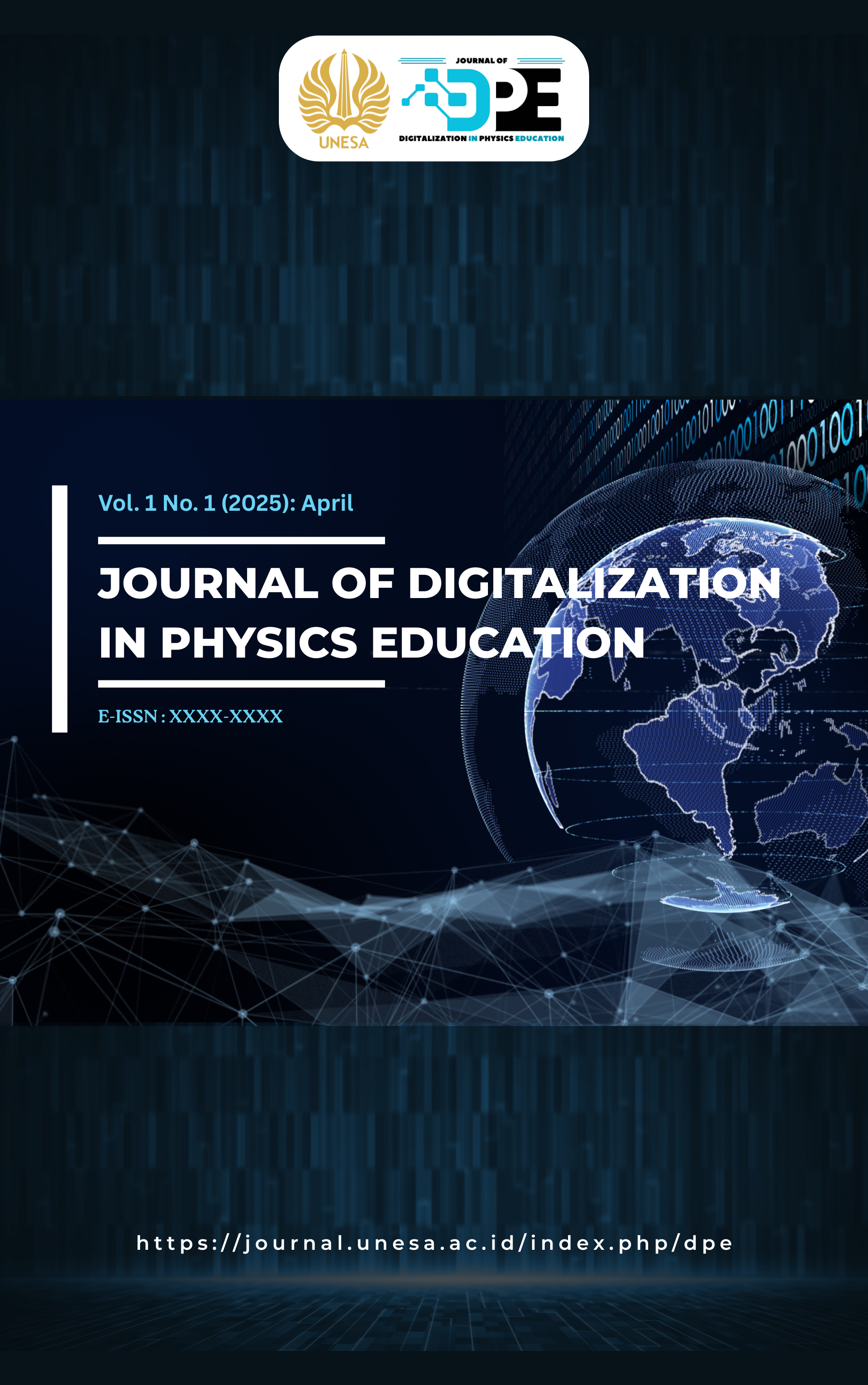Development of Interactive Physics Learning Website Based On STEAM Approach to Increase Student Learning Motivation in Optics Chapter
DOI:
https://doi.org/10.26740/jdpe.v1i1.38994Keywords:
Learning Media, Physics Education, STEAM, Education Website, ICTAbstract
Objective: Changing times and technological advances influence the world of education. Therefore, prospective educators are required to be able to utilize existing technology in classroom learning activities. This research aims to produce Physics learning media by applying the STEAM approach to increase student learning motivation on optics. The learning media developed is an interactive Physics learning website based on the STEAM approach. Method: The type of research conducted is the development of learning media. The media development model used is the ADDIE model. The learning media trial was conducted at SMAN 1 Gedangan with a research sample of 10 students. The instrument used in this study was a student response questionnaire. The data analysis technique used was quantitative descriptive analysis. Results: The results showed that the effectiveness of learning media in increasing student learning motivation had a score of 90.4% with very positive criteria. The developed learning media is effectively used in learning physics on optics. Based on the results of data analysis, it can be concluded that the interactive physics learning website based on the STEAM approach is feasible (very effective) in increasing student learning motivation.Novelty: Integrating the STEAM approach in this learning media provides a learning experience that combines theory with creativity, art, and problem-solving. Unlike conventional methods, the website features interactive tools to explore physics concepts through simulation and visualization, thus increasing student motivation and engagement.References
Aldila, F. T., Matondang, M. M., & Wicaksono, L. (2020). Identifikasi minat belajar siswa terhadap mata pelajaran fisika di SMAN 1 Muaro Jambi, Journal of Science Education and Practice, 4(2), 22–31. https://doi.org/10.33751/jsep.v4i1.2827
Bakri, F., Fajriani, F., & Muliyati, D. (2018). Media e-learning berbasis CMS joomla: Pelengkap pembelajaran fisika SMA, Jurnal Teknologi Pendidikan, 21(2), 99–110. https://doi.org/10.32550/teknodik.v21i2.346
Hariandi, J., Sitompul, S. S., & Habellia, R. C. (2023). Peningkatan keterampilan proses sains dengan menerapkan pendekatan STEAM, JPF (Jurnal Pendidikan Fisika) FKIP UM Metro, 11(2), 157–169. http://dx.doi.org/10.24127/jpf.v11i2.7945
Harsanto, B. (2017). Inovasi Pembelajaran Di Era Digital: Menggunakan Google Sites dan Media Sosial. Bandung: UNPAD PRESS.
Kartika, I., Aroyandini, E. N., Maulana, S., & Fatimah, S. (2022). Analisis prinsip konstruktivisme dalam pembelajaran fisika berbasis Science, Technology, Engineering, Art, and Mathematics (STEAM), Jurnal Pembangunan Pendidikan: Fondasi dan Aplikasi, 10(1), 23–33. https://doi.org/10.21831/jppfa.v10i1.46381
Lumembang, M. M., & Bandari, T. (2024). Utilitas platform digital pada pembelajaran fisika kelas X MAN Pinrang di masa endemi, Al-Irsyad Journal of Physics Education, 3(1), 28–40. https://doi.org/10.58917/ijpe.v3i1.104
Nawahdani, A. M., Triani, E., Azzahra, M. Z., Maison, M., Kurniawan, D. A., & Melisa, D. (2022). Hubungan minat dan motivasi belajar siswa terhadap mata pelajaran fisika, Jurnal Penelitian dan Pengembangan Pendidikan, 6(1), 12–18. https://doi.org/10.23887/jppp.v6i1.41986
Rohmadi, M., & Septiana, N. (2023). Pengembangan majalah fisika pada materi usaha dan energi terintegrasi islam, JIPFRI (Jurnal Inovasi Pendidikan Fisika dan Riset Ilmiah), 7(2), 93–105. https://doi.org/10.30599/jipfri.v7i2.1207
Rusli, M., Hermawan, D., & Supuwiningsih, N. N. (2020). Memahami E-Learning: Konsep, Teknologi, dan Arah Perkembangan. Yogyakarta: Penerbit Andi.
Serevina, V., Raihanati., & Andriana, W. (2020). Development of website on general physics subject to increase analytical skills of students, Journal of Physics: Conference Series, 1481(012081). https://doi.org/10.1088/1742-6596/1481/1/012081
Sina, S. A., Uloli, R., & Abdjul, T. (2023). Website development as a physics learning media on heat and its transfer materials, Jurnal Penelitian Pendidikan IPA, 9(8), 5874–5883. https://doi.org/10.29303/jppipa.v9i8.4189
Solihudin JH, T. (2018). Pengembangan e-modul berbasis web untuk meningkatkan pencapaian kompetensi pengetahuan fisika pada materi listrik statis dan dinamis SMA, Jurnal Wahana Pendidikan Fisika, 3(2), 51–61. https://doi.org/10.17509/wapfi.v3i2.13731
Sugiyono. (2013). Metode Penelitian Kuantitatif, Kualitatif, dan R&D. Bandung: ALFABETA.
Tenzin, S., Tendar, P., & Zangmo, N. (2022). Enhancing students' understanding of abstract concepts in physics by integrating ICT in teaching- learning process, Asian Journal of Education and Social Studies, 26(2), 68–80. https://doi.org/10.9734/ajess/2022/v26i230624
Widarti, R., & Roshayanti, F. (2021). Potensi implementasi STEAM (Science, Technology, Engineering, Art and Mathematic) berorientasi ESD (Education for Sustainable Development) dalam pembelajaran fluida, Unnes Physics Education Journal, 10(3), 290–295. https://doi.org/10.15294/upej.v10i3.55702
Downloads
Published
How to Cite
Issue
Section
License
Copyright (c) 2025 Journal of Digitalization in Physics Education

This work is licensed under a Creative Commons Attribution 4.0 International License.
 Abstract views: 334
,
Abstract views: 334
, PDF Downloads: 195
PDF Downloads: 195


